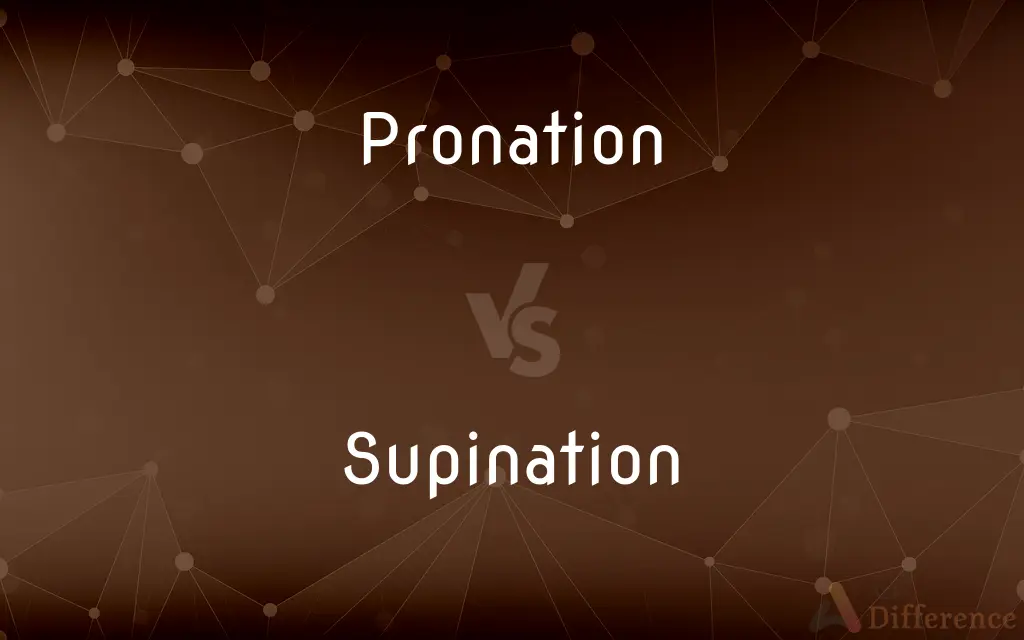Pronation vs. Supination — What's the Difference?
Edited by Tayyaba Rehman — By Maham Liaqat — Updated on March 25, 2024
Pronation involves the inward roll of the foot during motion, while supination is the outward roll, affecting balance and stride.

Difference Between Pronation and Supination
Table of Contents
ADVERTISEMENT
Key Differences
Pronation refers to the natural inward roll of the foot following a heel strike, crucial for shock absorption and balance during walking or running. This motion allows the foot to adapt to different surfaces, providing stability. On the other hand, supination is the foot's outward roll, opposite to pronation, playing a key role in the body's natural way of providing rigidity and leverage for propulsion. This movement is essential for the push-off phase, mainly involving the heel, big toe, and second toe.
While pronation distributes weight and absorbs shock, excessive pronation can lead to overuse injuries like shin splints and plantar fasciitis. It's often addressed with motion control footwear or orthotics to provide stability. Conversely, supination, or underpronation, is less common and can lead to ankle instability, Achilles tendonitis, and iliotibial band syndrome. Individuals with high arches typically exhibit more supination and may require footwear with cushioning and flexibility to aid in shock absorption.
In biomechanics, pronation involves a combination of dorsiflexion, eversion, and forefoot abduction. It's a complex movement that contributes to lower limb function. Whereas supination combines plantarflexion, inversion, and forefoot adduction, creating a rigid lever for efficient force transmission from the foot to the ground.
Pronation is often misunderstood as a negative trait, but it's a crucial part of normal gait. It becomes a concern only when it's excessive and leads to biomechanical imbalances. On the flip side, supination's role is equally important but tends to be less focused on, despite its significance in providing foot stability and facilitating an efficient push-off.
Both pronation and supination are necessary for a healthy, dynamic gait, each playing a role in different phases of movement. Recognizing the balance and interplay between these motions can help in identifying gait abnormalities and selecting the appropriate footwear or orthotic interventions to promote optimal foot health and performance.
ADVERTISEMENT
Comparison Chart
Definition
Inward roll of the foot during motion, primarily for shock absorption.
Outward roll of the foot, aiding in foot stability and push-off.
Common in
People with low arches or flat feet.
Individuals with high arches.
Biomechanics
Involves dorsiflexion, eversion, and forefoot abduction.
Combines plantarflexion, inversion, and forefoot adduction.
Role in Gait
Absorbs shock and adapts to various surfaces for balance.
Provides rigidity for leverage and propulsion during push-off.
Potential Issues
Overpronation can lead to injuries like shin splints and plantar fasciitis.
Underpronation may cause ankle instability, Achilles tendonitis, and iliotibial band syndrome.
Compare with Definitions
Pronation
A characteristic seen in flat-footed individuals.
Flat feet tend to pronate more to absorb shock.
Supination
Outward roll of the foot, enhancing stability.
Supination stiffens the foot for efficient push-off.
Pronation
Inward roll of the foot during walking or running.
Pronation helps in distributing the impact of landing evenly.
Supination
Associated with high foot arches.
High arches typically lead to more supination.
Pronation
Movement contributing to foot flexibility and adaptation to surfaces.
Proper pronation ensures stability on uneven terrain.
Supination
Essential for force transmission during gait.
Effective supination aids in propelling the body forward.
Pronation
Controlled by muscles and tendons for balance.
The posterior tibial muscle regulates pronation.
Supination
Less common than pronation but vital for balance.
Proper supination prevents excessive ankle rolling.
Pronation
Can lead to overuse injuries if excessive.
Overpronation often results in repetitive stress injuries.
Supination
Can be problematic if excessive, leading to injuries.
Excessive supination strains the ankle and outer foot.
Pronation
To turn or rotate (the hand or forearm) so that the palm faces down or back.
Supination
To turn or rotate (the hand or forearm) so that the palm faces up or forward.
Pronation
To turn or rotate (the foot) by abduction and eversion so that the inner edge of the sole bears the body's weight.
Supination
To turn or rotate (the foot) by adduction and inversion so that the outer edge of the sole bears the body's weight.
Pronation
To place in a prone position.
Supination
To be supinated; undergo supination.
Pronation
To become pronated.
Supination
The act or state of lying face upward, on one's back.
Pronation
To assume a prone position.
Supination
(anatomy) The act of rotating the forearm so that the palm of the hand is turned up or forward, or the resulting state of the forearm
Pronation
Walking on the inner edge of the foot.
Supination
(anatomy) The act or state of combined adduction and inversion of the foot.
Pronation
(anatomy) The action of rotating the forearm so that the palm of the hand is turned down or back.
Supination
(fencing) The position of the sword hand when the palm is facing up.
Pronation
(fencing) The position of the sword hand when the palm is facing down
Supination
The act of turning the hand palm upward; also, position of the hand with the palm upward.
Pronation
The act of turning the palm or palmar surface of the forefoot downward.
Supination
Rotation of the hands and forearms so that the palms face upward
Pronation
Rotation of the hands and forearms so that the palms face downward
Common Curiosities
Can excessive pronation or supination be harmful?
Yes, excessive pronation can lead to overuse injuries like shin splints, while too much supination may cause ankle instability and other issues.
How are pronation and supination controlled?
These movements are regulated by a combination of muscles, tendons, and the biomechanical structure of the foot and ankle.
What is pronation?
Pronation is the natural inward roll of the foot during walking or running, essential for shock absorption and stability.
How do pronation and supination affect gait?
Pronation helps in shock absorption and adapting to surfaces, while supination provides rigidity for leverage and propulsion, both essential for a balanced and efficient gait.
What shoes are best for supinators?
Supinators should look for shoes with plenty of cushioning and flexibility to aid in shock absorption.
What are the signs of overpronation?
Signs include flat feet, inward ankle rolling, and uneven shoe wear on the inside edge.
What kind of shoes should overpronators wear?
Overpronators benefit from motion control or stability shoes that offer support and correct improper foot motion.
What is supination?
Supination is the outward roll of the foot, crucial for providing foot stability and facilitating an efficient push-off during movement.
Are there exercises to correct overpronation?
Yes, strengthening and stretching exercises for the foot, ankle, and lower leg can help correct overpronation.
When should I see a professional for pronation or supination issues?
If you experience pain, discomfort, or recurrent injuries related to walking or running, consult a healthcare professional.
How can I tell if I supinate?
Signs include high arches, ankle rolling outward, and wear on the outer edge of your shoes.
Can supination be corrected with exercises?
Strengthening and flexibility exercises, particularly for the foot and ankle, can help manage supination issues.
Can custom orthotics help with pronation or supination?
Custom orthotics can be very effective in managing excessive pronation or supination by providing tailored support and alignment.
Is it normal to have some degree of pronation or supination?
Yes, both pronation and supination are normal parts of the gait cycle, necessary for efficient movement.
Share Your Discovery

Previous Comparison
Glee vs. Glad
Next Comparison
Sacked vs. FiredAuthor Spotlight
Written by
Maham LiaqatEdited by
Tayyaba RehmanTayyaba Rehman is a distinguished writer, currently serving as a primary contributor to askdifference.com. As a researcher in semantics and etymology, Tayyaba's passion for the complexity of languages and their distinctions has found a perfect home on the platform. Tayyaba delves into the intricacies of language, distinguishing between commonly confused words and phrases, thereby providing clarity for readers worldwide.














































